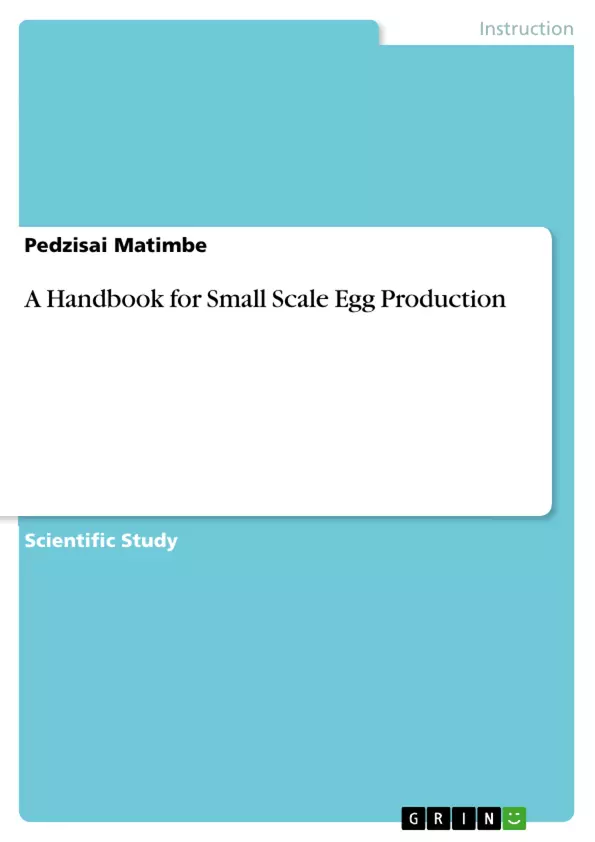This handbook provides useful information on how to keep layer hens profitably.
It sheds light on factors to consider when selecting layer breeds, brooding and all critical management practices from day old up to marketing of eggs. Farmers need to grasp this hand book so that they will be able to produce a healthy flock.
I recommend farmers to make use of this book without reservations because information and experience offered in this book is valuable.
Farmers and inspired readers can make use of this hand book as a foundation to carry out researches as well as generating new ideas.
Wish you the best of all luck in egg production.
Inhaltsverzeichnis (Table of Contents)
- LAYER BREEDS
- Factors to consider when choosing a breed.
- BROODING
- HOUSING REQUIREMENTS.
- Brooder hygiene.....
- REARING PULLETS
- Housing requirements.
- Deep litter system
- NUTRITIONAL REQUIREMENTS.
- WATER REQUIREMENTS
- Ration changes..\li>
- Midnight feedings .
- Light stimulation....
- Lighting programs To achieve good early Egg size..\li>
- MANAGEMENT OF POINT OF LAY HENS
- HOUSING AND EQUIPMENT FOR P.O.L HENS .
- Floor space.
- EQUIPMENT FOR 200 BIRDS.
- Laying nests
- Feeders
- Waterers.
- Perches.
- House climate...
- Lighting
- Feeding..\li>
- EGG COLLECTION AND PACKAGING
- STORAGE OF EGGS DURING THE LAYING SEASON.
- MARKETING OF EGGS.
- Direct Marketing..\li>
- POUTRY DISEASES.
- VIRAL DISEASES..
- BACTERIAL DISEASES
- INFECTIOUS RESPIRATORY DISEASE..
- PARASITIC DISEASES.
- NEOPLASTIC DISEASES
Zielsetzung und Themenschwerpunkte (Objectives and Key Themes)
This handbook aims to provide practical guidance for farmers on profitable layer hen management. It covers key aspects from breed selection and brooding through to egg marketing, emphasizing the importance of proper care and management practices.
- Selecting the most suitable layer breed for specific production goals.
- Ensuring optimal brooding conditions for healthy chick development.
- Implementing effective management practices for rearing pullets and point-of-lay hens.
- Understanding the nutritional and environmental requirements for egg production.
- Recognizing and managing common poultry diseases to maintain flock health.
Zusammenfassung der Kapitel (Chapter Summaries)
The handbook begins by discussing layer breeds, highlighting factors to consider when choosing a breed, such as egg production potential and body weight. The subsequent chapter focuses on brooding, covering the essential requirements for creating a safe and hygienic environment for young chicks. It emphasizes the importance of temperature control, ventilation, and biosecurity measures.
The chapter on rearing pullets delves into the management practices needed for raising layer chicks, emphasizing proper feeding and housing requirements. It also touches upon the importance of stress management to ensure optimal egg production.
The handbook then moves on to the management of point-of-lay hens, addressing housing, equipment, and feeding strategies for maximizing egg production. The final chapters cover egg collection, packaging, storage, and marketing, providing practical guidance on these aspects of the egg production enterprise.
Schlüsselwörter (Keywords)
Layer breeds, brooding, rearing pullets, point-of-lay hens, housing requirements, nutritional needs, disease management, egg production, marketing, poultry health, biosecurity.
- Arbeit zitieren
- Pedzisai Matimbe (Autor:in), 2015, A Handbook for Small Scale Egg Production, München, GRIN Verlag, https://www.hausarbeiten.de/document/306294


